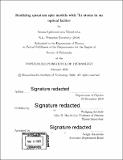Realizing quantum spin models with ⁷Li atoms in an optical lattice
Author(s)
Dimitrova, Ivana Ljubomirova.
Download1201522216-MIT.pdf (47.59Mb)
Other Contributors
Massachusetts Institute of Technology. Department of Physics.
Advisor
Wolfgang Ketterle.
Terms of use
Metadata
Show full item recordAbstract
Quantum spin Hamiltonians are paradigmatic models, which display different kinds of quantum phase transitions, strongly-correlated and topological ground states, and various regimes of transport. Expanding their significance, many mappings exist between quantum spin models and other systems in different areas of physics, mathematics, and beyond. Even though quantum spin models have been studied extensively, there are still many open questions. Simulating these Hamiltonians with the system of ultracold atoms in optical lattices provides a new perspective with the wide tunability of parameters and the minimal coupling to the environment. The mapping involves using the Mott insulating state of ultracold atoms in optical lattices, where the energy of a second-order tunneling process (superexchange) maps to the parameters of a Heisenberg model. This thesis provides a detailed roadmap for the design and building of such a quantum simulator with ⁷Li atoms in optical lattices. Each step of the process is described, together with the methods and techniques used for the building and the characterization of the physical system. A focus is placed on using the Mott insulator as a starting point for spin physics experiments and, in particular, on the characterization and improvements of the mapping from a density sector description to a spin sector description of the system. Several schemes for implementing and studying spin systems are presented. In particular, the feasibility of implementing the Heisenberg spin-1/2 and spin-1 models in this system is described. The tilted lattice is presented as a tool for studying pure superexchange-driven dynamics and for increasing their timescale by suppressing first order tunneling and the role of number defects. The first measurements and the tuning with this machine of superexchange-driven dynamics over a wide range in the anisotropic Heisenberg spin-1/2 models are presented. Finally, the versatility of the BEC 5 machine is showcased by a study which does not involve an optical lattice. It explores the realization of an exotic quantum phase, a supersolid, in a new way. After many years of building and improvements, the BEC 5 machine emerges as a repeatable and reliable quantum simulator which has a clear scientific agenda of exploring many-body ground states and non-equilibrium dynamics.
Description
Thesis: Ph. D., Massachusetts Institute of Technology, Department of Physics, February, 2020 Cataloged from PDF version of thesis. Includes bibliographical references (pages 279-292).
Date issued
2020Department
Massachusetts Institute of Technology. Department of PhysicsPublisher
Massachusetts Institute of Technology
Keywords
Physics.